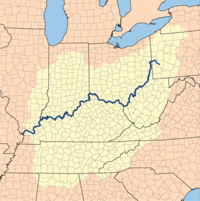
Photo from wikipedia
The hazards posed by infrequent major floods to communities along the Susquehanna River and the ecological health of Chesapeake Bay remain largely unconstrained due to the short length of streamgage… Click to show full abstract
The hazards posed by infrequent major floods to communities along the Susquehanna River and the ecological health of Chesapeake Bay remain largely unconstrained due to the short length of streamgage records. Here we develop a history of high‐flow events on the Susquehanna River during the late Holocene from flood deposits contained in MD99‐2209, a sediment core recovered in 26 m of water from Chesapeake Bay near Annapolis, Maryland, United States. We identify coarse‐grained deposits left by Hurricane Agnes (1972) and the Great Flood of 1936, as well as during three intervals that predate instrumental flood records (~1800–1500, 1300–1100, and 400–0 CE). Comparison to sedimentary proxy data (pollen and ostracode Mg/Ca ratios) from the same core site indicates that prehistoric flooding on the Susquehanna often accompanied cooler‐than‐usual winter/spring temperatures near Chesapeake Bay—typical of negative phases of the North Atlantic Oscillation and conditions thought to foster hurricane landfalls along the East Coast.
Journal Title: Geophysical Research Letters
Year Published: 2019
Link to full text (if available)
Share on Social Media: Sign Up to like & get
recommendations!